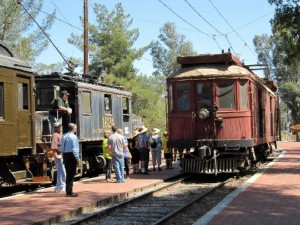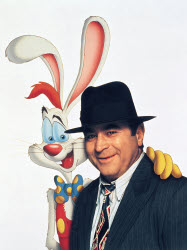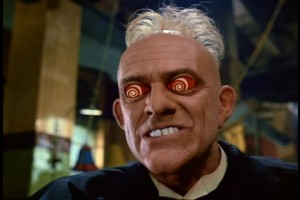KCET public television in Los Angeles covered the history of Los Angeles rail for the “Lost LA” series hosted by Nathan Masters, from the Red Cars to the modern Metro Rail system. Nathan interviewed me on the latter system, featured in the video below toward the end.
The episode is worth watching in full for an entertaining and informative recap of Red Car history. Nathan goes for a dive off the coast to try to find old streetcars sunk to create reefs and takes a ride on a preserved car at a rail museum.
I also wrote a companion article for KCET on this history, “From Rail to Roads and Back Again: The Rebirth of L.A.’s Public Transit,” based on my 2014 book Railtown (UC Press). While Los Angeles will never again have such a comprehensive rail transit system as with the Red Cars, the modern Metro Rail system is helping to fill important mobility gaps and helping to build a new city oriented around convenient rail service.
Robert L. Davis, a longtime Angeleno from the San Gabriel Valley, emailed me an update on the construction of the Gold Line light rail extension to Azusa. Davis sent me some recollections on San Gabriel train history that I posted last year. He remembers the original Pacific Electric streetcar lines on the right-of-way, back when the area from his boyhood was “a land of cow pastures and orange groves”:
Although I can remember my mother buying milk at an East Pasadena dairy where it came from cows we knew personally, and when I was in kindergarten in Monrovia, we little ones went on a field trip to an orange packing plant near our school (Santa Fe School, named after the railway), them days is gone forever.
His update on the Gold Line extension construction (sent in December):
This photo was taken on Nov. 23 and is already outdated. The trolley wire is now suspended from the messenger cable and is in place from here (California Ave.) to Mayflower Ave. in Monrovia. The photo is looking east, and from here the wire goes all the way past the Miller brewery in Irwindale. Except for the final “fine tuning”, the track is complete from Sierra Madre Villa to the Azusa-Glendora boundary:
And then a nice comparison of modern overhead wire installation compared to the old school:
A Mass Electric Construction crew installing the trolley wire in Duarte, near the City of Hope Medical Center. I found this process interesting, being a some-time member of the Overhead Lines dept. at Orange Empire Railway Museum (oerm.org):
This is how the Pacific Electric did it–a crew of volunteer linemen at OERM electrifying the north main line with a wooden tower car. One of my “dreams come true” is running this relic, which went by my house when I was a lad:
Many thanks to Robert for passing along these photos, updates, and recollections.
I was saddened to hear of the passing of actor Bob Hoskins, who was fantastic in the 1988 blockbuster “Who Framed Roger Rabbit?” The movie was one of my all-time favorites, but unfortunately the fictional plot propogated false conspiracy theories about the demise of LA’s old streetcar rail network. For those who haven’t seen it (spoiler alert), the villain in the movie, Judge Doom (played by Christopher Lloyd), buys up the Pacific Electric streetcar network in Los Angeles to convert it to freeways. I vividly remember watching it in the theater and hearing the audience laugh heartily at this dialogue:
Judge Doom: A few weeks ago I had the good providence to stumble upon a plan of the city council. A construction plan of epic proportions. We’re calling it a freeway.
Eddie Valiant: Freeway? What the hell’s a freeway?
Judge Doom: Eight lanes of shimmering cement running from here to Pasadena. Smooth, safe, fast. Traffic jams will be a thing of the past.
To this day, when I tell people about Railtown, my book on LA’s rail history, they frequently ask me about the conspiracy theory that car companies deliberately destroyed Los Angeles’ once-great streetcar network, and they often mention Roger Rabbit. One transit agency veteran whom I interviewed for Railtown, Richard Stanger, told me that he credits the film with helping to motivate voters to approve Proposition C, the 1990 sales tax measure that dedicated new funds for rail expansion.
The problem is that the conspiracy theory about the demise of rail transit in LA is wrong. As Martin Wachs and other scholars have documented, the Pacific Electric system of the past was not all it was cracked up to be, and like many cities around the country, it fell victim to the widespread popularity of the automobile.
LA, like other cities in the late nineteenth century, took advantage of electric streetcar technology to expand its reach outside of the commercial core. But when the car was introduced, Angelenos took to the technology en masse. Because Los Angeles had a much smaller population at the time, the car represented freedom to go anywhere quickly. The streetcars, by contrast, were slow, expensive, and unpleasant. They began to lose money, and the public refused to step in and rescue them. This story happened in cities all over the United States at the time.
Then in 1974, along came Bradford Snell, a young government attorney who testified that General Motors and other auto interests bought up the Pacific Electric lines to destroy them and force people to buy cars. As Cliff Slater documented, however, UCLA transportation scholars like Wachs and George Hilton and a number of respected journalists (including the pro-rail New Electric Railway Journal) comprehensively refuted these claims at the time.
But Snell’s charges caught the public imagination and have been repeated by some elected officials ever since. The Roger Rabbit movie further popularized the theory.
So while we mourn the passing of Hoskins and celebrate the fun of “Who Framed Roger Rabbit?”, let’s put to rest this conspiracy idea. It does not help solve the traffic and environmental problems of today, and by discounting the popularity of the automobile and what the technology represents to many people, it undercuts sensible strategies to convince people to take transit, walk, or bike over driving. But more importantly, the theory is just wrong.
Let’s let it rest in peace, along with Mr. Hoskins.
I received an email from Robert L. Davis, a longtime Angeleno who remembers the original Pacific Electric streetcar lines from his boyhood. He grew up near the old Monrovia line, which shared the Pasadena lines as far as South Pasadena and San Marino. The old line is defunct and now filling up with housing units. Here is an edited, abridged version of his recollections:
I grew up on Fifth Ave. in Monrovia, on the north side of the Pacific Electric (PE) right-of-way. From the time I was old enough to notice, to the sad days in 1952 when the track and trolley wire were ripped out, PE was part of my life. Typical weekday service was a car every half-hour to Monrovia, with every other car continuing to Glendora. Rush hours would see two and three car trains running on ten or fifteen minute headways. Add to this a daily freight train, a daily “box motor”, and assorted work cars, and there was a lot to watch.

Two PE “home-brew” cars (built in Torrance in 1925) and the big brown tower car (built in Los Angeles in 1915) with the author running it.
When I was in fourth grade at Monroe School, the westbound freight rumbled past around 1:30 PM on its way to Los Angeles. The City of Monrovia had installed a stop sign at Olive and Mayflower, where the track left street-running and resumed private right-of-way, and I’d hear the hiss of air brakes and the clanking of the train coming to a halt. The head brakeman probably got off to flag the crossing, and the engineer (by this time the electrics had given way to diesel power) would turn on the air-operated bell and start up with more rattling and clanking as the slack pulled out. Whatever was under discussion in class was totally lost to me.
Diesel locomotives started appearing on freights in the late 1940’s. As late as the mid-1970’s, diesels used on former PE lines in Santa Monica, Beverly Hills and West Hollywood had interurban-style whistles, and engineers (some of whom were ex-PE motormen) were forbidden to use regular air horns on the “Westside”. Back in 1968 I decided to check out the Hollywood Midnight Switcher. I found the crew switching on Santa Monica Blvd. After the switching was completed, I followed the unit all the way through Beverly Hills, soaking up the mellow toot of the air whistle and the rumble of wheels on well-worn rails.
Pacific Electric’s track through Monrovia was in poor condition and was mostly original 1903 steel. Any plans for retaining rail service past 1951 would have had to include completely rebuilding the track. Construction of the Santa Ana/San Bernardino Freeway past Union Station canceled any hope of that happening by taking PE’s exit from downtown toward the San Gabriel Valley. The idea of building a grade-separated rapid transit line was discussed, but no business or political entity would ante-up the money.
Today the Red Car era lives on, especially during special events, such as “Pacific Electric Weekend,” which has been observed during June in 2006 and 2007 and may become an annual event. Every ex-PE unit that runs comes out for photo ops and (if feasible) passenger service. In addition, visitors to the west side of the Los Angeles Harbor at San Pedro can ride replica Red Cars built under the sponsorship of the L.A. Harbor Department. The cars, which represent PE suburban cars from 1915 or thereabouts, run Friday through Sunday from the Cruise Ship Terminal to 22nd St.
Thirty years ago, if someone had said, “The Long Beach Line, parts of the San Bernardino Line, and a section of the San Fernando Valley Line will reappear,” such predictions would be greeted with “dream on” and “what have you been smoking lately?” Traction fan gatherings would be devoted to slides and movies of long-vanished trolley lines and plans for trips to San Francisco to ride the west coast’s last outpost of streetcar service. Today, between the four Metro Rail electric lines and the seven Metrolink services, it would take a long day to cover even a good percentage of the original Pacific Electric lines.







